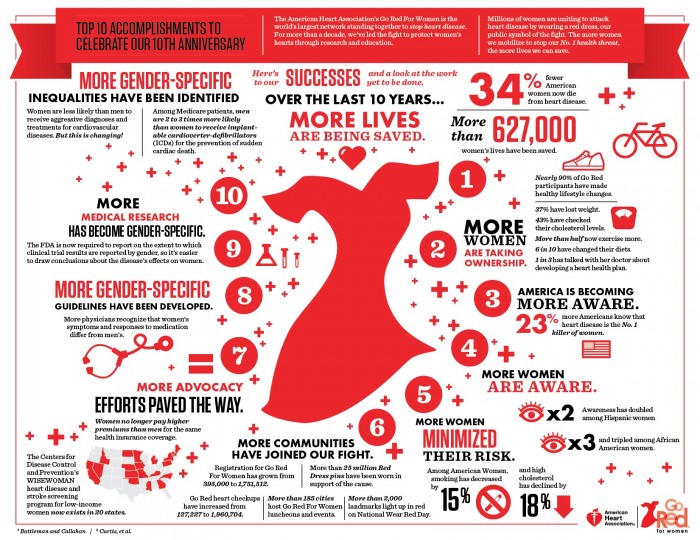Posts Tagged ‘American Heart Association’
National Wear Red Day Celebrates 13 Years of Combating Heart Disease and Stroke in Women on Friday, February 5.
Celebrate National Wear Red Day on Friday, February 5 by wearing red, of course!!
February is American Heart Month and in that spirit, the American Heart Association wants to remind women that heart disease and stroke cause 1 in 3 deaths annually among women. Sadly, that accounts for the death of one woman every 80 seconds!
Fortunately, the majority of cardiac and stroke problems may be prevented just through education and healthy lifestyle adjustments. This is why National Wear Red Day was started–to help women make changes that may save their lives. The infograph above highlights how much change has occurred over just the last ten years.
To find out about the many, many accomplishments that have taken place in women’s heart health over the past ten years, go HERE.
To find out more about “Going Red for Women” and National Wear Red Day, go HERE.
Go RED for Heart Month. By Our February Student Pharmacist, Ericka Panek.
Throughout the month of February, the American Heart Association educates about heart disease and prevention. So in the spirit of Valentine’s Day and Heart Awareness Month, I thought I would educate you about high blood pressure.
High blood pressure, also known as hypertension, is often called the “silent killer” because it can go unnoticed by the patient. You may wonder why your doctor takes your blood pressure every time you sit down in the office and this is why. Many people who are diagnosed with high blood pressure have no symptoms. If untreated for too long, high blood pressure can start to damage your heart, your arteries, and other organs. For this reason, it’s important to see your doctor at least once per year for a yearly physical, even if you haven’t been sick.
Like many diseases later in life, what we do now can have an impact on our future. Here are some tips about what you can do to reduce your risk of high blood pressure.
- Enjoy regular physical activity! I know you hear this all the time, but that is because exercise is important. Regular physical activity can be specific to each person: brisk walking, swimming, running, hiking, fitness classes, or team sports. Find something you enjoy. Make the exercise a group or family activity. Give the exercise priority.
- Avoid tobacco use! Did you know that every cigarette you have actually increases your blood pressure temporarily, even for up to 20 minutes after you finish it? Did you also know that one year after quitting, your risk of coronary heart disease is HALF of what it was while you were smoking?
- Manage your stress level. Stress causes us to go into a “fight or flight” situation, which if faced with a threat is beneficial, but when we are chronically stressed it can negatively affect our health. Everyone handles stress differently, so take the time to learn from yourself what stresses you out and how you can manage that stress. Further information can be found HERE: (http://www.helpguide.org/mental/stress_management_relief_coping.htm)
Education is the first step to living a healthier life. The second step is doing something with that knowledge. Since this month is all about awareness and education, I challenge you to spread the word about high blood pressure. If you have any questions or want to check your blood pressure here at the pharmacy, just ask!
High Blood Pressure: How High is Too High? By Katheryn Schafer, Student Pharmacist!
Everyone needs a blood pressure. However, high blood pressure, also known as hypertension, can be dangerous. Over 76 million US adults have been diagnosed with high blood pressure, but many more may be at risk and not even know it. Many people with high blood pressure feel completely fine and have no symptoms at all. But just because a person cannot feel high blood pressure does not mean it is harmless.
What is considered normal blood pressure? The American Heart Association (AHA) considers normal blood pressure to be a reading of less that 120 for your systolic pressure (the top number on your blood pressure monitor) and less than 80 for your diastolic pressure (the bottom number). High blood pressure would be a systolic pressure over 140 and a diastolic pressure over 90. To see a chart that shows high and normal blood pressure numbers, go HERE.
High blood pressure can lead to damaged blood vessels. Just like high water pressure can burst pipes in a house, high blood pressure can cause tears in blood vessels, which can lead to stroke and other serious health problems.
High blood pressure can be prevented. Living a healthy lifestyle is one of the best ways to reduce your risk for developing high blood pressure.
Here are ways you can reduce your risk:
- Decrease the amount of salt in your diet: a high salt diet causes your body to retain water, which increases your blood pressure and can overwork your heart.
- Exercise: physical activity can help to strengthen your heart, which will help your body maintain a healthy blood pressure.
- Avoid tobacco smoke: smoking raises blood pressure and causes fatty build up in arteries, which can also contribute to high blood pressure.
For more resources on high blood pressure, check out these websites and be sure to talk to your pharmacist!
http://www.cdc.gov/bloodpressure/






